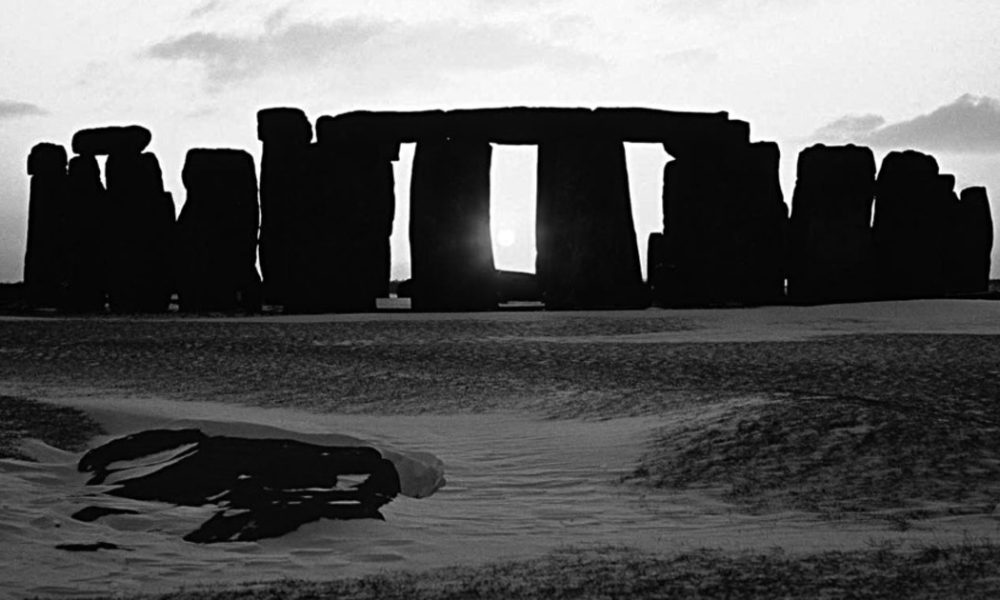 Winter solstice at Stonehenge. PHOTO PROVIDED/English Heritage, UK
Winter solstice at Stonehenge. PHOTO PROVIDED/English Heritage, UK
I actually prefer using the more inclusive ”Happy Holidays.” For me it has nothing to do with political correctness or desire to please or at least not offend anybody. It just comes down to the fact that our celebration at the time of Christmas is such a mashup of beliefs and adopted practices from so many eras and cultures that singling out one phrase hardly seems fair.
Eclipsing the fact that Hanukkah and Kwanzaa both happen around this time, there is the great granddaddy of all winter celebrations that occurs around Dec. 21 annually: the winter solstice!
This year it will happen exactly on Saturday at 8:19 p.m. The dates and times wander around each year due the pesky fact that it takes 365.2422 days for the sun to circle the sun, which is also the reason that we have leap years, centuries and seconds to keep our calendars accurate.
The winter solstice occurs at that moment when the Earth’s axis is at its maximum tilt away from the sun. This tilt gives us our seasons, and if the planet rotated on a straight axis perpendicular to the sun, we would have one more or less uniform season throughout the year.
Instead, the tilt leads to there being one day each year where the daylight is the shortest and the night the longest. For us that happens in December, while our friends south of the equator are facing the polar opposite, their longest day of the year.
In the northern hemisphere, if you happen to be above the polar circle you will experience polar night, where the sun will be at or below the horizon and the best you can hope for is some feeble twilight to illuminate the darkest day of the year. While I have never experienced this aspect of winter solstice, I have twice spent summer solstices above the Arctic Circle (in Alaska and Finland) and had the complete opposite, ”midnight sun.” This is an amazing experience where it is light for 24 hours and if you have no schedule to maintain, time becomes meaningless.
But back to the dreary dark of winter: since prehistory, the winter solstice was an especially critical time for our ancestors. For them it was essential to be able to monitor the passing of the seasons, not with celebration in mind, but survival. Starvation during the winter was a very real possibility for our neolithic relatives. They had to be able to know when to plant, breed animals, store and monitor food reserves. The stone edifices of Stonehenge and Newgrange in Ireland have demonstrable astronomical qualities showing when the winter solstice occurs through their alignment – stone-age chronometers, as it were.
And while economic forces were behind keeping track of winter solstice, it was in fact a time of celebration. For one, it signaled that the days that had been steadily been growing shorter would turn the corner and gradually become longer again. Also, there was the fact that most animals would be slaughtered for food, because it was too difficult to feed them through the winter, so there was an abundance of fresh meat available. Beer and wine which had been fermenting since the harvest would also become ready about this time, so all the ingredients for a party were at the table.
Facing the tough haul of winter but buoyed by the returning light gave rise to celebrations of the rebirth of sun gods in most cultures, including Indian, Iranian, Roman and East Asian. The pagan Germanic and Scandinavian peoples celebrated a sun-based holiday in winter called Yule. We still refer to it with ”Yuletide carols” or the Yule log.
In ancient Rome, one of the main festivals of the year was called ”Saturnalia” and was centered on the winter solstice, which according to the calendar of the day, the Julian, fell on Dec. 25. If this date sounds familiar, it should.
But the solar calendar created by Julius Caesar wasn’t perfect and the date wandered around and was off by some 11 days before Pope Gregory XIII sorted things out and introduced the modern calendar in 1582. The Eastern Orthodox Church still uses the Julian dates, so their Christmas is celebrated in January – Jan. 7, 2020 this time.
All the maneuvering and meandering of the dates as calendars searched for accuracy is confusing and difficult for historians when sorting out when, exactly, an event happened. One event that had a phenomenal impact on our world was the birth of young Jewish lad in Bethlehem. There is no recorded date or record of this that we can point to, but the question has been debated and theorized about over the centuries.
The history of the various arguments and rationales for setting the birth of ”the reason for the season,” Jesus Christ, on Dec. 25 makes for interesting reading. One reason more biological than theological was counting nine months ahead of the Annunciation, when the angel visited Mary with great tidings. The church had set the date of that event on March 25, the vernal equinox.
Before the year 325 AD, when the Roman Catholic Church was officially organized, there was no mention of celebrating the nativity. In fact, in those days, the celebration of birthdays was considered pagan and undesirable. But by the time the church got together, interest in setting a date for the birth of the Savior was reaching a fever pitch. While the first record of Christmas being celebrated in Rome was on Dec. 25, 336, it wasn’t official until Pope Julius I decreed it so in 350 AD.
In Europe, the prominence of Christmas wavered back and forth over the centuries. For a while, the Epiphany – focusing on the visit of the three wise men – overshadowed the nativity.
A dispute over Christmas led ultimately to the split into Eastern and Western Christianity. In 800 AD, Charlemagne was crowned on Christmas day, helping to promote this as a day of celebration. By the High Middle Ages, the holiday had become so important that when King Richard II of England hosted a holiday feast in 1377, 28 oxen and over 300 sheep were devoured.
Holly, evergreens, ivy and caroling were part of medieval Christmas celebrations, as was gift-giving. But instead of the gifts going to loved ones it was more along the lines of legal relationships such as tenant and landlord.
Contemporary reports of these early celebrations often complain of drunkenness, gambling, promiscuity and other misbehaviors that seem to harken back to the old pagan celebrations. This behavior so offended the Puritans of England that they banned Christmas in the 17th century and it wasn’t until the Restoration that it was allowed again as a legal public holiday in the year 1660.
At this point I want to jump forward to take a peek at some of the symbols and practices that we observe at this time of the year. The traditional Christmas colors are red, green and gold. Red is for Christ’s blood, green symbolizes eternal life – such as an evergreen which doesn’t lose its leaves – and gold was one of the gifts of the Magi.
The Christmas tree, also an evergreen, traces back to German Lutherans. It may go back even further to pagan ancestors their solstice practices, but there is a record of a Christmas tree in the Strasbourg Cathedral in 1539. Moravians placed candles on their trees, which we continue in a safer manner with electric lights. A star placed on the top is to remember the Star of Bethlehem.
Also symbolizing that star is the poinsettia, a plant native to Mexico and popular since the 16th century – and conveniently also red and green. Going with this theme are holly, Christmas cactus and mistletoe (despite bearing white berries).
Much festive fare and attire appears at this time of the year. In England, roast goose and plum pudding feature prominently, while across the water a rehash of Thanksgiving foods is common although many families have their own special holiday favorites. Jewish families often go out for Chinese food on Christmas as a holiday tradition.
Gift-giving is common and a gift-giver in a red suit is almost universal. Known as Santa Claus, the Weihnachtsmann, Kris Kringle, St. Nicholas, Babbo Natale, among other names.
It is St. Nicholas that gives us Santa Claus. This 4th-century Greek bishop was known for his care of children, generosity and giving of gifts. As early as the 1200s, St. Nick was venerated in the Netherlands and gift-giving in his name was popular.
This practice spread out from there. But instead of the gifts arriving on Christmas, it was on St. Nicholas’ feast day, Dec. 6.
To this day, St. Nicholas’ Day is the big one for the Dutch. Children leave out a shoe for ”Sinterklaas” to find. He will leave, among other things, a chocolate letter of their initial, special treats, a personalized poem and other gifts. Christmas Day in Holland is a quiet one for visiting family and having a meal, with no other real celebration.
This Sinterklaas becomes Santa Claus in our culture and comes on Christmas Eve. A stocking hung with care may be a nod to the Dutch tradition of leaving out a shoe.
In Austria and other parts of Germanic Europe, the Kristkindl or Christ Child comes on Christmas Eve and, while the family expectantly waits away from the main living area, works his magic. A bell is heard and the family enters to find a completely decorated tree with lit candles, presents and treats where none existed before. Quite a feat.
This Christ Child was a result of the Reformation and Protestants wanting to distance themselves from Catholic veneration of saints. It also gives us the name Kris Kringle – one of Santa’s many aliases.
And so, for this holiday season, I wish to say to you: have a very happy winter solstice, Happy Hanukkah, Joyous Kwanzaa, any others I have missed and, well, Happy Christmas!
Dana Merryday is a weekly Chronicle contributor for all things Cottage Grove. He can be contacted at [email protected].








